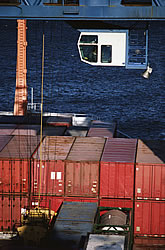Detection of corrosion
Surface corrosion in existing structures is often difficult to detect and expensive to repair. Mainly because such surfaces are coated with substances like paint and petroleum and the degree of corrosion is often subjective. Moreover, current surface preparation techniques are associated with low-productivity, high costs and hazardous for workers and environment alike. In large surfaces such as ship hulls, the difficulties are compounded by rigours of execution and lack of confidence, therefore compromising the effective and total removal of corrosion. These drawbacks often undermine the decision-making process in evaluating the degree of corrosion present, its whereabouts and the appropriate surface preparation technique required. Under the EC funded project, AIMS, a non-destructive testing method based on image processing techniques was developed. Its primary function is to support the decision-making process by providing a better understanding of corroded elements and the degree of corrosion present as well as in indicating the surface treatment response required. Capable of assessing textured features that distinguish plates at different stages of corrosion and quality features of surface preparation the system now provides quantified condition assessment of coated steelworks. As such, it provides decision makers the confidence to determine whether a chemical or physical treatment of corroded surfaces is required. This in turn could result in both time and costs savings as well as a reduction in waste by-products. An additional benefit of the technology is that it may also advance alternative surface restoration methods. The technology is usable in shipyards, petrochemical plants and any other industry where large steel constructs may suffer from corrosive elements.







